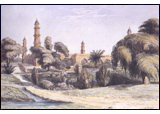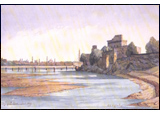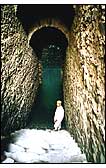 |
Dr.
Abdul Rehman Standing
on the Grand Trunk Road
|
|
|
|
|
|
|
 |
|
|
The
City of Lahore
Seen from Shahdara
|
 |
|
|
|
 |
A network
of roads linked Afghanistan and the Potowar plateau with the Punjab
plains. The route between Sheikhupura and Shahdara was a part
of a longer route from Delhi to Lahore and beyond to Kabul; and
it was also one of the most important routes of communication
between these cities. This route was frequently used by the emperors
Akbar, Jahangir, and Shah Jahan on their way to Kabul and Kashmir.

The
complete route comprised various stages. Sheikhupura-Shahdara
was the first stage. From there one proceeded to Hafizabad and
then crossed River Chenab and reached Qadirabad in Gujrat district.
From Qadirabad the road went further on to Rasul, which was a
principal ferry landing for the river Jhelum. After crossing Jhelum
the road proceeded to Salt Range and then to Tilla Jogian. After
Rohtas, the traveler would then take the Sher Shah Suri alignment
and proceed to Kabul via Attock and Peshawar.

Shahdara literally
means the "principal entrance," as it was the principal stopping
point before entering that city and the first halting station
after crossing the river Ravi. The Mughal emperors, royal ladies,
and other important nobles built gardens in Shahdara, along the
banks of the Ravi. The pleasure gardens of Mirza Kamran (brother
of Emperor Humayun)and Nur Jahan (wife of Emperor Jahangir) were
among the most famous examples of the Shahdara gardens, before
the area began the transition to a royal funerary landscape after
the death of Jahangir in 1627.
|
 |
|
|

The section between Shahdara and Sheikhupura has always been a fertile
plain traversed by a number of perennial streams, which bring water
from Jammu and Kashmir during the monsoon season. The most important
of these are Nala Dek and Nala Bhed. High water remains in these
streams throughout the monsoon season, so permanent bridges were
built over them using bricks and lime mortar. The most impressive
among these is the one at Kot Pindi Das, which survives in very
good condition. This bridge is still being used by heavy trucks.
The bridges were flanked by roads paved in brick using a variety
of geometrical patterns; traces of these pavements still survive.
 |
|
|
Salih
Kamboh, a historian of Shah Jahan, mentioned these bridges in connection
with the emperor's journey from Kashmir to Lahore: "There were
large, torrential rains this year and all the country between Lahore
and Sheikhupura was heavily flooded; the bridges constructed recently
became innundated, and therefore His Majesty decided to halt a few
more days in Sheikhupura." |
 |
|
|
 – |
|
|
|

This section of the road was supplemented with various infrastructure
at expedient locations for the traveler. Trees were planted alongside
the road for shade and fruit at convenient spots. Now, only palm
trees are apparent at certain locations. The nearby villages provided
food and other necessities, but baolis (step–wells)
and mosques were also important amenities. Built during Akbar's
reign, the baoli and mosque at Jandiala Sher Khan near Sheikhupura
were extremely impressive; the structure of the baoli, in fact,
is one of the most magnificent among all surviving baolis in Pakistan.
Today, however, Jandiala Sher Khan is perhaps best known for its
shrine to the poet Waris Shah, famous for his rendition of the
Punjabi love story of Hir and Ranjha.

The alignment of this imperial road was changed during the British
period, and the historic road sank into oblivion. Today the bridges
are located amidst agricultural fields and are inaccessible.
|
 |
 |
 |
 |
|